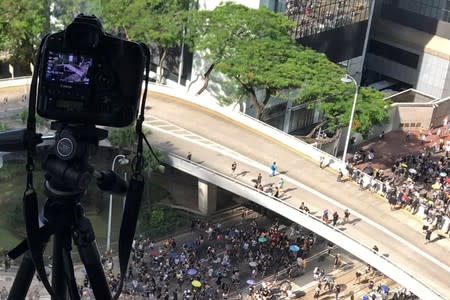Backstory: How Reuters counted a quarter million people at Hong Kong's protests
HONG KONG (Reuters) - When large-scale demonstrations plunged Hong Kong into political crisis, the size of the crowds quickly became a contentious issue.
Police provided relatively low estimates and the protest organizers gave much higher numbers, both trying to prove a point.
For Reuters, this was an opportunity to provide an independent estimate that would be an indicator of political sentiment in one of the world's premier financial hubs.
To do this, a team led by Deputy Head of Graphics Simon Scarr used Google Earth and TripAdvisor, fishing chairs and sunscreen, and pored over 18 hours of video to come up with an estimate of the size of the crowd in the streets.
Scarr first went through the three-km (two-mile) route of a march scheduled for July 1 step by step, spending hours on Google Earth to pin down locations where the bulk of the protesters would need to funnel through. These would be the places to monitor and measure the flow of the crowd.
"I spent time scouring the area for bridges and vantage points, looking down from them from all angles," Scarr said. "Eventually I was able to find a few elevated positions that would cover anyone marching to the government headquarters or end portion of the march."
One of these vantage points was from a hotel. Scarr looked through traveller photographs taken from the hotel on TripAdvisor. Sure enough, one holiday maker shared a view of the city which incorporated the exact spot on the road the team needed.
Data Visualisation developer Marco Hernandez, based in Hong Kong, visited the sites and took test images and video.
Once the key spots were finalised, Scarr, along with Manas Sharma, another member of the graphics team based in Singapore, flew to Hong Kong. Together with Hernandez and journalists from the Hong Kong bureau, they split into three teams.
The main monitoring station was at the chosen hotel, with a camera recording HD video pointed at the march route below. A second camera caught additional material and also served as a backup.
The other two counting stations, on footbridges, relied on smaller cameras. Anticipating the long hot day ahead, the team packed water, sunscreen and hats along with protective gear and press credentials. They also took along folding fishing chairs for the long day ahead.
A QUARTER MILLION HEADS
It took over four hours to capture the march on video from start to finish.
Then it was time to count the numbers, manually. The team used 30 second bursts of video at regular intervals and counted the number of people crossing a particular point. The numbers were then extrapolated for the length of the march.
The result - an estimated 227,000 people took part in the march, versus police estimates of 190,000 and the organizers claim of over half a million participants.
Reuters' calculations are an estimate of the total number taking part in the march. They do not include protesters who did not march. The result was detailed here: "How many protesters took to the streets on July 1?" https://tmsnrt.rs/2FRUKtU
"The people here are very passionate about their city and it seems easy to get caught up in that, but reporting the facts we could actually see was our aim," Hernandez said.
(Editing by Raju Gopalakrishnan)




